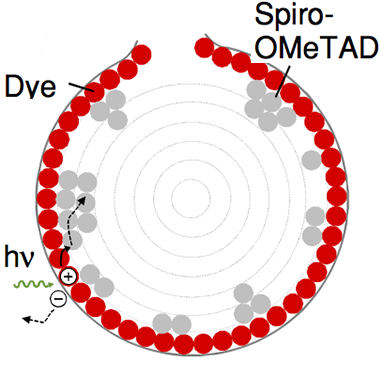 Dependence of Dye Regeneration and Charge Collection on the Pore-Filling Fraction in Solid-State Dye-Sensitized Solar Cells
Weisspfennig et al. Adv. Funct. Mater., 0:ASAP (Sep 2013)
Dependence of Dye Regeneration and Charge Collection on the Pore-Filling Fraction in Solid-State Dye-Sensitized Solar Cells
Weisspfennig et al. Adv. Funct. Mater., 0:ASAP (Sep 2013)
[ pdf ][DOI:10.1002/adfm.201301328] |
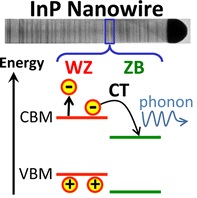 Direct Observation of Charge-Carrier Heating at WZ–ZB InP Nanowire Heterojunctions
Yong et al. Nano Lett., 13:1 (Aug 2013)
Direct Observation of Charge-Carrier Heating at WZ–ZB InP Nanowire Heterojunctions
Yong et al. Nano Lett., 13:1 (Aug 2013)
[ pdf ][ DOI:10.1021/nl402050q]
We show that type II heterointerfaces in semiconductor nanowires can sustain a hot charge-carrier distribution over an extended time period. In photovoltaic applications, such heterointerfaces may hence both reduce recombination rates and limit energy losses by allowing hot-carrier harvesting |
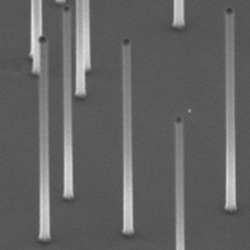 Electronic properties of GaAs, InAs and InP nanowires studied by terahertz spectroscopy
Joyce et al. Nanotechnology,24:214006 (May 2013)
Electronic properties of GaAs, InAs and InP nanowires studied by terahertz spectroscopy
Joyce et al. Nanotechnology,24:214006 (May 2013)
[ pdf ][ DOI:10.1088/0957-4484/24/21/214006 ]
Using terahertz conductivity spectroscopy, we have assessed the ultrafast electronic properties of GaAs, InAs and InP nanowires. InAs nanowires exhibited extremely high electron mobility, highlighting their immediate suitability for high mobility devices. InP nanowires exhibited the longest carrier lifetimes, highlighting their potential for photovoltaics. |
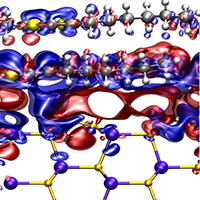 Strong Carrier Lifetime Enhancement in {GaAs} Nanowires Coated with Semiconducting Polymer
Yong et al. Nano Lett.,12:6293–6301 (Dec 2012)
Strong Carrier Lifetime Enhancement in {GaAs} Nanowires Coated with Semiconducting Polymer
Yong et al. Nano Lett.,12:6293–6301 (Dec 2012)
[ pdf ][ DOI:10.1021/nl3034027]
We observe strong carrier lifetime enhancement for nanowires blended with semiconducting polymers. The enhancement in such inorganic-organic hybrids is found to depend crucially on the ionization potential of the polymers with respect to the Fermi energy level at the surface of the (GaAs) nanowires. |
 Extreme sensitivity of graphene photoconductivity to environmental gases
Docherty et al. Nat. Commun.,3:1228 (Nov 2012)
Extreme sensitivity of graphene photoconductivity to environmental gases
Docherty et al. Nat. Commun.,3:1228 (Nov 2012)
[ pdf ][DOI:10.1038/ncomms2235 ]
We show that the photoconductivity of graphene at terahertz frequencies is dramatically altered by the adsorption of atmospheric gases, such as nitrogen and oxygen. Furthermore, we observe the signature of terahertz stimulated emission from gas-adsorbed graphene. |
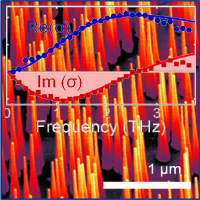 Ultra-low Surface Recombination Velocity in InP Nanowires Probed by Terahertz Spectroscopy
Joyce et al. Nano Lett.,12:5325-–5330 (Oct 2012)
Ultra-low Surface Recombination Velocity in InP Nanowires Probed by Terahertz Spectroscopy
Joyce et al. Nano Lett.,12:5325-–5330 (Oct 2012)
[ pdf ][ DOI:10.1021/nl3026828]
Using terahertz spectroscopy we measured long charge carrier lifetimes and a remarkably low surface recombination velocity in InP nanowires. We found that the carrier mobility is strongly limited by the presence of crystallographic defects, such as zinc-blende/wurtzite polytypism and stacking faults in these InP nanowires. |






No comments:
Post a Comment